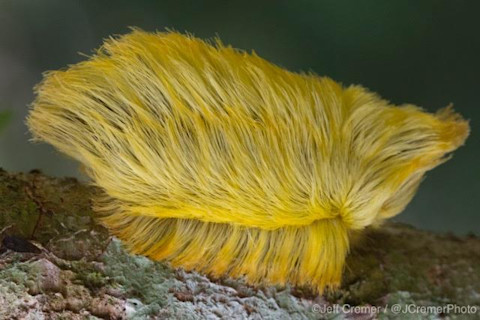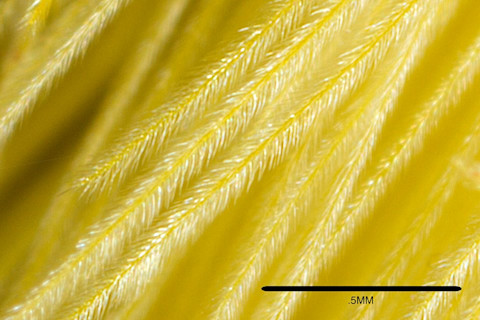Many have wondered about exact nature of Donald Trump’s hair. Is it the world’s worst toupee? A poorly-executed elaborate comb-over? A weird, incredibly expensive weave? The world may never know. But I prefer to think it’s inspired by nature—not another human’s lovely locks, of course, but those of this animal, which some have taken to calling the Donald Trump Caterpillar or simply the Trumpapillar:

Meet the Trumpapillar. Photo Credit: Jeff Cremer
Prior to this election season, the animal was known as the Flannel Moth Caterpillar or the Asp Caterpillar (Megalopyge opercularis). As an adult, the Trumpapillar is equally fur-tastic:

The fuzzy adult flannel moth. Photo Credit: Patrick Coin
But while the adult is a plush hybrid between moth and cat, the young caterpillar’s golden hairs are not just fluff. The Donald Trump Caterpillar isn’t just a surprisingly-accurate mimic of The Donald’s hair—it’s even more venomous than its namesake. The lovely waves of dandelion “fur” which so perfectly emulate the Republican candidate’s locks are actually dangerous spines capable of delivering potent toxins.

Macro shot of the Trumpapillar's venomous hairs. Photo Credit: Jeff Cremer
Macro shot of the Trumpapillar’s venomous hairs. Photo Credit: Jeff Cremer
According to the scientific literature, contact with the fine hairs—what scientists call ‘setae’—is an awful experience. “Intense, throbbing pain develops immediately or within five minutes of contact with the caterpillar,” explains David Eagleman in Clinical Toxicology. And we’re not talking a little boo-boo—as Eric Hossler explains in an article in Dermatologic Therapy, some patients liken the amount of pain to “a broken bone, kidney stones, or being hit with a hammer or baseball bat.” A characteristic grid of blood-colored spots mark the site of the sting for about a day afterwards. And pain isn’t the only symptom—Eagleman writes that responses to stings “can include headaches, nausea, vomiting, intense abdominal distress, lymphadenopathy, lymphadenitis, and sometimes shock or respiratory stress.”
Impressive, for a wiggling wig.
In fact, the animal is so venomous that there are creatures—other than The Donald—which attempt to mimic its look, as Joe Hanson explains:
While these photos were taken in the Amazon, this furry monster isn’t just found south of the border; its range extends through Texas all the way up to Maryland and down through Florida. Many Americans have Trumpy toupees crawling around their backyards and don’t even know it! So if you live in the south, keep an eye out—you’ll regret rubbing elbows with the Trumpapillar even more than these Apprentice contestants do with its namesake.













